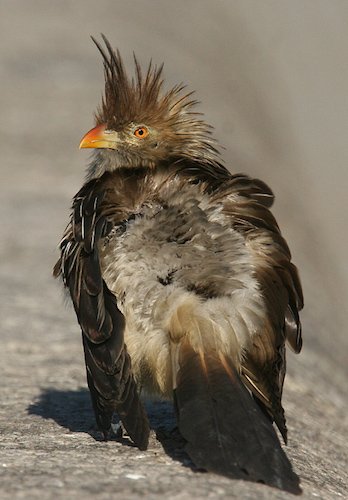Patagonia

Birding Patagonia
Patagonia is not a province of Argentina but a well-known area extending into several provinces and a bio-faunal region. I give it its own page as there are trip reports for the area and some conservation organisations which cover it.Patagonia is a geographic region containing the southernmost portion of South America. Located in Argentina and Chile, it comprises the Andes mountains to the west and south, and plateaux and low plains to the east. The name Patagonia comes from the word patagón used by Magellan to describe the native people who his expedition thought to be giants. It is now believed the Patagons were actually Tehuelches with an average height of 1.80 m (~5’11”) compared to the 1.55 m (~5’1″) average for Spaniards of the time.
To the east of the Andes, it lies south of the Neuquén River and Colorado rivers, and, to the west of the Andes, south of (39°S), excluding the Chiloé Archipelago. East of the Andes the Argentine portion of Patagonia includes the provinces of Neuquén, Río Negro, Chubut, Santa Cruz, and Tierra del Fuego, as well as the southern tips of the provinces of Buenos Aires, Mendoza and La Pampa. The Chilean portion embraces the southern part of the region of Los Lagos, and the regions of Aisén and Magallanes. It excludes those portions of Antarctica claimed by both countries.
Argentine Patagonia is for the most part a region of vast steppe-like plains, rising in a succession of abrupt terraces about 100 metres (330 ft) at a time, and covered with an enormous bed of shingle almost bare of vegetation. In the hollows of the plains are ponds or lakes of brackish and fresh water. Towards the Andes the shingle gives place to porphyry, granite, and basalt lavas, animal life becomes more abundant and vegetation more luxuriant, acquiring the characteristics of the flora of the western coast, and consisting principally of southern beech and conifers. The high rainfall against the western Andes (Wet Andes) and the low sea surface temperatures offshore give rise to cold and humid air masses, contributing to the ice-fields and glaciers, the largest ice-fields in the Southern hemisphere outside of Antarctica.Among the depressions by which the plateau is intersected transversely, the principal are the Gualichu, south of the Río Negro, the Maquinchao and Valcheta (through which previously flowed the waters of lake Nahuel Huapi, which now feed the river Limay); the Senguerr (spelled Senguer on most Argentine maps and within the corresponding region), the Deseado River. Besides these transverse depressions (some of them marking lines of ancient inter-oceanic communication), there are others which were occupied by more or less extensive lakes, such as the Yagagtoo, Musters, and Colhue Huapi, and others situated to the south of Puerto Deseado, in the centre of the country. In the central region volcanic eruptions, which have taken part in the formation of the plateau from the Tertiary period down to the present era, cover a large part with basaltic lava-caps; and in the western third more recent glacial deposits appear above the lava. There, in contact with folded Cretaceous rocks, uplifted by the Tertiary granite, erosion, caused principally by the sudden melting and retreat of the ice, aided by tectonic changes, has scooped out a deep longitudinal depression, which generally separates the plateau from the first lofty hills, the ridges generally called the pre-Cordillera, while on the west of these there is a similar longitudinal depression all along the foot of the snowy Andean Cordillera. This latter depression contains the richest and most fertile land of Patagonia. Lake basins along the Cordillera were also excavated by ice-streams, including Lake Argentino and Lake Fagnano, as well as coastal bays such as Bahía Inútil.
For links to resources see the state pages of Rio Negro, Neuquén, Chubut, Santa Cruz & Tierra del Fuego.
-
Number of bird species: 460
(As at May 2019)
-
Birds of Patagonia, Tierra del Fuego and Antarctic Peninsula
(The Falkland Islands and South Georgia) | By E Couve & C Vidal | Fantastico Sur | 2003 | Paperback | 656 pages, 200 colour photos, distrib maps | ISBN: 9789568007041 Buy this book from NHBS.com
-
Aves de la Patagonia Argentina
WebsiteImages, voices, legends, descriptions, readings, comments.
-
Birding Patagonia
Tour OperatorAfter less than an hour’s drive we will arrive at the estancia which lies in the midst of incredible countryside, between the Patagonian Steppe and the ecotone. On the cliff walls here it is possible to view Andean condors, black-chested buzzard eagles and several other attractive bird species, such as the austral parakeet which is endemic to Patagonia. -
Trogon Tours
Tour OperatorTrogon Tours is the official nature travel company of Birding Argentina, the leading birding and nature specialists for southern South America since 2001
-
2016 [12 December] - Matt Eade
PDF ReportThis trip to Argentina was put on either side of a 3-week voyage to Antarctica via the Falklands and South Georgia. Other then the first day I concentrated on Patagonia only, where I set myself many targets, with the top target being the Hooded Grebe. -
2022 [01 January] - Rob Jansen
PDF ReportMammals and birds
-
Observando Aves en Bariloche
WebsiteRegistro de observaciones de aves en Bariloche
-
Patagonian Birds
Gallery

